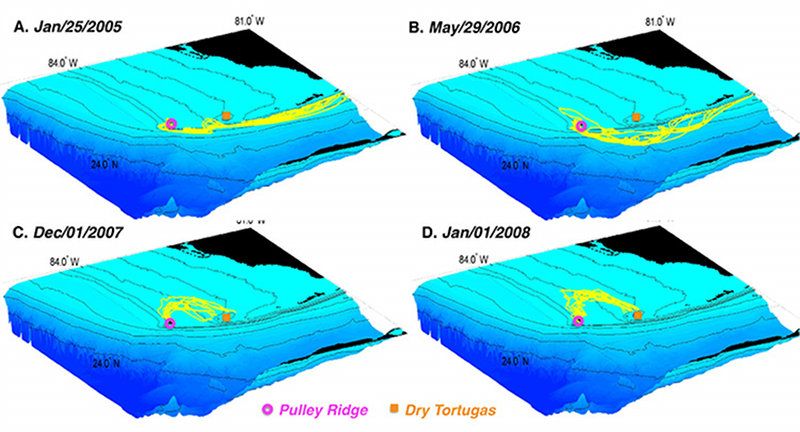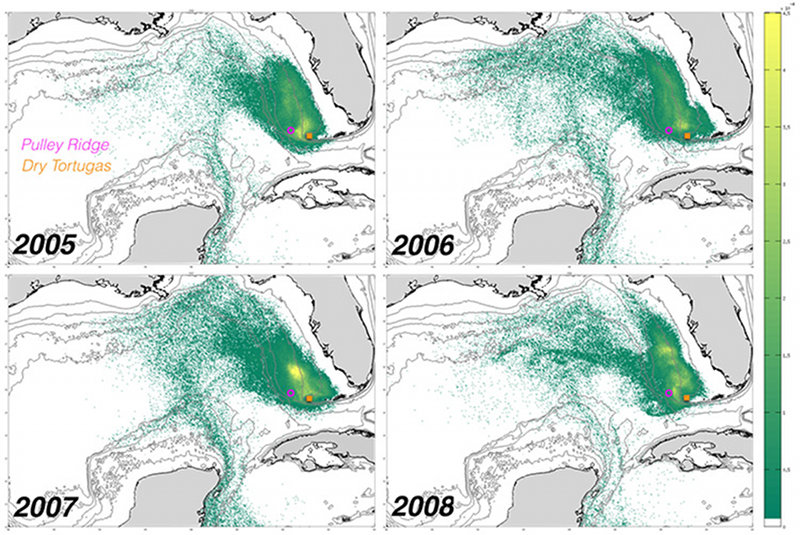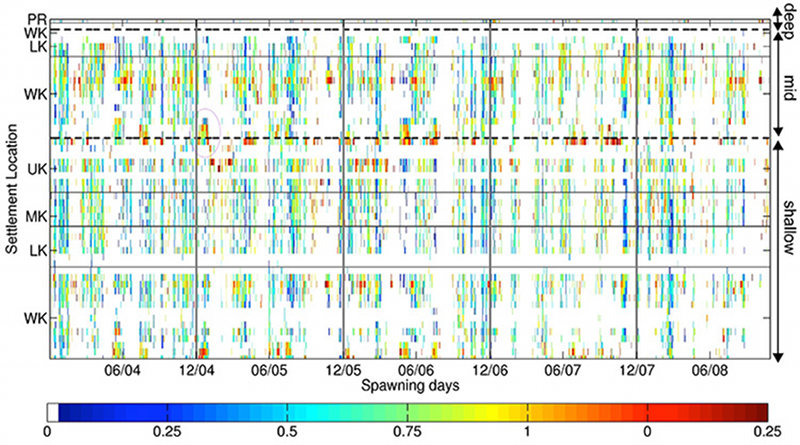
By Claire Paris, University of Miami’s Rosenstiel School of Marine and Atmospheric Science

Figure 1. Mesophotic to Shallow Reef Connectivity: Larval trajectories for bicolor damselfish (Stegastes partitus) spawning at Pulley Ridge are shown in three dimensions. These trajectories depict the spawning events that generated high settlement pulses of larvae to the Lower Florida Keys (A & B), and to the Dry Tortugas (C & D). The events were identified by spectral analysis of successful settlement of larvae in the model and were found to be modulated by the oceanography (passage of the Loop Current, the proximity of the Florida Current) and the biology (spawning time and ontogenetic migration of the bicolor damselfish larvae). They are highlighted (magenta ellipse) in figure 3 showing the daily settlement of larvae from Pulley Ridge to the Florida Keys. Images courtesy of Ana Vaz. Download larger version (jpg, 1.7 MB).
The persistence of coral reef ecosystems may largely depend on the exchange of offspring between populations that exist on the edge of species ranges. While reef-building corals expand to the subtropics, their range is not only bounded by latitude, but also by water depth. This is mostly because sunlight attenuates very quickly through the water column and corals harbor microscopic photosynthetic symbiotic algae, which need to uptake light to help nourish the coral.
Light-dependent coral reefs and associated benthic communities found between 30 and 100 meters (100-330 feet) in the Gulf of Mexico are called mesophotic coral ecosystems (MCEs) and are central to our study. The MCEs of Pulley Ridge, located 66 kilometers west of the Dry Tortugas, inhabit a relatively stable environment, decoupled from stresses related to the proximity of coastal pollution or from water temperature fluctuations and mass bleaching affecting shallower reefs. Many of the species living at Pulley Ridge are also found in shallower water, and they may be related.
The overarching question we are trying to answer is whether the corals, sponges, and reef fishes, including grouper, living at Pulley Ridge share their larvae with the shallower coral reef ecosystems of the Dry Tortugas and the Florida Keys. The answer will tell us if Pulley Ridge helps sustain these shallower reefs or vice versa and determine if it would benefit from further protection.

Figure 2. Sources of Larvae to Pulley Ridge: Inter-annual variability of larval sources are simulated by backward particle tracking during 40 days from a single release site located at 60 meters in the Pulley Ridge area (magenta circle). An ensemble of probabilistic simulations are achieved by daily release of particle for five years, from January 2004 to December 2008. The highest larval contribution (in yellow) to Pulley Ridge comes from the western Florida shelf and the Dry Tortugas; both areas represent significant sources of larvae to the mesophotic coral reef ecosystem of Pulley Ridge over the years. Other less frequent upstream larval sources (in green) show some degree of connectivity with the Yucatan peninsula. The gray lines along the coastline indicate the location of the 30-meter, 60-meter, 300-meter, 500-meter, and 1000-meter isobath. Image courtesy of Claire Paris and Ana Vaz. Download larger version (jpg, 477 KB).
Coral reef ecosystems are complex. One of the most important factors in their survival is their ability to reproduce, and their successful reproduction is largely dependent on the critical phase of larval transport and connectivity. When corals and reef fish spawn, their minute eggs and larvae must face incredible challenges in the expansive dimensions of the oceans. These microscopic processes are nearly impossible to detect or monitor in such open areas and the larvae are simply too small to be tagged.
To predict the movement and trajectories of larvae in the ocean, as well as their final destination, we use biophysical models. Biophysical models take into account focused field sampling, with remotely operated vehicles (ROVs) and the In-situ Ichthyoplankton Imaging System, that collect visual data on the benthos, fish and plankton in the water column; the physical oceanography; and biological information on the growth and reproduction of target organisms, to make predictions on the degree of connectivity between ecosystems.
Genetic information of the relatedness of species populations is a necessary complementary approach to confirm expected probabilities of vertical connections between mesophotic and shallow reefs. However, genetic data cannot inform us on the timing and the underlying processes that regulate successful larval pathways.

Figure 3. Connectivity Through Time: Time series of daily arrival of bicolor damselfish (Stegastes partitus) larvae from Pulley Ridge and the Florida Keys. The color of each node in the graph represents the daily probability of connectivity, with highest probability in red, lowest probability in blue, and no connections in white. WK = Western Keys (25 sites), LK = Lower Keys (10 sites), MK = Middle Keys (5 sites), UK = Upper Keys (8 sites), PR = Pulley Ridge. Virtual larvae are released in the biophysical model in three Pulley Ridge locations from 2004 to 2008. Dashed lines delineate different depth strata, i.e., shallow = 0-20 meters, mid = 20-40 meters, deep = 40-80 meters. The mid and deeper strata represent the mesophotic coral ecosystem (MCE) in the model. Image courtesy of Claire Paris and Ana Vaz. Download larger version (jpg, 1.4 MB).
Biophysical modeling is the most comprehensive approach to address these critical questions. Such an approach integrates the detailed knowledge of three major components provided by the expert groups involved in the project. The primary component is the structure of the habitat and the mesophotic community (fish and benthos) observed with ROV surveys, which points to hot spots of the spawning populations and larval production. A second and equally important component is the oceanography of the region since knowledge of currents and eddies are essential to simulate the transport of larvae in the ocean. Thirdly, demographic measures (fecundity, growth, and longevity) and larval traits such as pelagic duration, swimming behavior, and survival rates of the target species interact with the two other components, currents and habitat, and modulate the larval trajectories and detach them from the passive transport of water masses between reefs.
The model output can be effectively used to quantify the capacity of MCEs in sustaining the shallow coral reef communities and to find the key locations of source populations that are critical to protect. Another powerful application of the biophysical modeling is to reveal the underlying coupled physical-biological mechanisms that connect mesophotic and shallow coral ecosystems and may contribute the persistence of coral reef communities in a changing environment.
Our project is focused on collecting vast amounts of biological and physical data, which provides essential information for biophysical models to predict movement and to verify the modeling output. All the field work and resulting data are input into a biophysical model to predict the movement of the microscopic, but growing and active, larvae and determine the source and destination (sink) role of the various populations surveyed by ROVs. Eventually key zones may be identified as bountiful, holding source or unusually productive populations and may be nominated to be protected to improve the chances of their dependent ecosystems surviving.